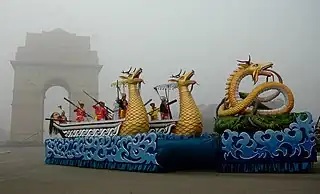Meitei mythology
Meitei mythology or Manipuri mythology (Meitei: Meitei Mi Lai Tingi Wari) is a collection of myths, belonging to the religious and cultural traditions of the Meitei people, the predominant ethnic group of Manipur. It is associated with traditional Meitei religion (Sanamahism). Meitei myths are a part of Meitei culture (Manipuri culture) and explain various natural phenomena, how the human civilization developed, and the reasons of many things happening. Most of the Meitei legends are found in the Meitei language (Manipuri language) texts.[1][2][3][4]
| Term | |
|---|---|
| English | Meitei mythology |
| Ancient Meitei | ꯃꯩꯇꯩ ꯃꯤ ꯂꯥꯢ ꯇꯤꯟꯀꯤ ꯋꯥꯂꯤ / ꯃꯤꯇꯩ ꯃꯤ ꯂꯥꯢ ꯇꯤꯟꯀꯤ ꯋꯥꯂꯤ (mei-tei mee lai teen-kee waa-lee) |
| Modern Meitei | ꯃꯩꯇꯩ ꯃꯤ ꯂꯥꯢ ꯇꯤꯟꯒꯤ ꯋꯥꯔꯤ / ꯃꯤꯇꯩ ꯃꯤ ꯂꯥꯢ ꯇꯤꯟꯒꯤ ꯋꯥꯔꯤ (mei-tei mee lai teen-gee waa-ree) |
| Assamese | মেইতেই পৌরাণিক কাহিনীসমূহ (mei-tei pou-raa-neek kaa-hee-nee-so-mooh) |
| Bengali | মেইতেই পুরাকথা (mei-tei poo-raa-ko-thaa) |
| Hindi | मैतै पौराणिक कथा (mei-tei pou-raa-neek ka-thaa) |
| Sanamahism | |
| Meitei mythology (Manipuri mythology) | |
|---|---|
| Stylistic origins | Ancient Kangleipak (early Manipur) |
| Cultural origins | Meitei culture (Manipuri culture) |
| Popularity | |
| Subgenres | |
| Epic cycles of incarnations | |
| Related topics | |
| Meitei religion (Sanamahism), Meitei folklore (Manipuri folklore), Meitei literature (Manipuri literature), Meitei cinema (Manipuri cinema) | |

| Part of a series on |
| Meitei mythology |
|---|
 |
|
|
| Mythology |
|---|
Textual sources
Mythical narration plays an integral role in nearly every genre of Meitei literature (Manipuri literature). Some of the best known literary sources are:
| Ancient texts | Description |
|---|---|
| Khongjomnubi Nongarol | Legends of six girls turning into the Pleiades in the sky[5][6][7] |
| Konthoujam Nongarol | Legends of Konthoujam Tampha Lairembi[8][9] |
| Leishemlon | Creation myth –Story of the creation of the universe[10][11][12] |
| Leithak Leikharol | Creation myth – the creation, genealogy of kings, moral teachings and mythology[13][14][15][16] |
| Panthoibi Khongul | Legends of that romantic adventure of Goddess Panthoibi and God Nongpok Ningthou[17][18][19] |
| Phouoibi Waron | Legends of the multitude of loves of Goddess Phouoibi[20][21][22][23][24] |
| Poireiton Khunthok | Legend of the human civilization on earth led by Poireiton and Leinaotabi from the underworld.[25][26][27][28][29][30] |
| Sakok Lamlen | Creation myth – a sequel to the myth expounded in the Leithak Leikharol[31][32][33][34] |
Mythical beings
Mythical beings include gods, goddesses, mythical creatures and many others.
References
- Hodson, Thomas Callan (2016-05-17). The Meitheis. Creative Media Partners, LLC. ISBN 978-1-356-86725-7.
- Laisram, Rena (2009). Early Meitei History: Religion, Society and the Manipur Puyas. Akansha Publishing House. ISBN 978-81-8370-163-1.
- Roy, L. Somi (2021-06-21). And That Is Why... Manipuri Myths Retold. Penguin Random House India Private Limited. ISBN 978-93-91149-65-9.
- Devi, Dr Yumlembam Gopi. Glimpses of Manipuri Culture. ISBN 978-0-359-72919-7.
- Meitei, Sanjenbam Yaiphaba; Chaudhuri, Sarit K.; Arunkumar, M. C. (25 November 2020). The Cultural Heritage of Manipur. Routledge. ISBN 978-1-000-29637-2.
- Singh, Lamabam Damodar (2000). L. Kamal Singh. Sahitya Akademi. ISBN 978-81-260-0856-8.
- Paniker, K. Ayyappa (29 August 1997). Medieval Indian Literature: Surveys and selections. Sahitya Akademi. ISBN 978-81-260-0365-5.
- Paniker, K. Ayyappa (1997). Medieval Indian Literature: Surveys and selections. Sahitya Akademi. p. 334. ISBN 978-81-260-0365-5.
- Ray, Asok Kumar; Chakraborty, Satyabrata (2008). Society, Politics, and Development in North East India: Essays in Memory of Dr. Basudeb Datta Ray. Concept Publishing Company. p. 85. ISBN 978-81-8069-572-8.
- Singh, Moirangthem Kirti (1998). Recent Researches in Oriental Indological Studies: Including Meiteilogy. Parimal Publications.
- North East India History Association. Session (1995). Proceedings of North East India History Association. The Association.
- Green, Thomas A.; Svinth, Joseph R. (2010). Martial Arts of the World: An Encyclopedia of History and Innovation [2 volumes]: An Encyclopedia of History and Innovation. ABC-CLIO. p. 294. ISBN 978-1-59884-244-9.
- Paniker, K. Ayyappa (1997). Medieval Indian Literature: Surveys and selections. Sahitya Akademi. p. 334. ISBN 978-81-260-0365-5.
- Panchani, Chander Sheikhar (1987). Manipur, Religion, Culture, and Society. Konark Publishers. ISBN 978-81-220-0047-4.
- Singh, Moirangthem Kirti (1993). Folk Culture of Manipur. Manas Publications. ISBN 978-81-7049-063-0.
- Singh, Moirangthem Kirti (1988). Religion and Culture of Manipur. Manas Publications. ISBN 978-81-7049-021-0.
- Society and Economy in North-East India. Regency Publications. 2004. ISBN 978-81-87498-83-4.
- Zama, Margaret Ch (2013). Emerging Literatures from Northeast India: The Dynamics of Culture, Society and Identity. SAGE Publishing India. p. 79. ISBN 978-81-321-1746-9.
- North East India History Association. Session (2003). Proceedings of North East India History Association. The Association.
- Paniker, K. Ayyappa (1997). Medieval Indian Literature: Surveys and selections. Sahitya Akademi. ISBN 978-81-260-0365-5.
- Meitei, Sanjenbam Yaiphaba; Chaudhuri, Sarit K.; Arunkumar, M. C. (2020-11-25). The Cultural Heritage of Manipur. Routledge. ISBN 978-1-000-29637-2.
- N.A (1959). MEDIEVAL INDIAN LITERATURE AN ANTHOLOGY VOL. 3. SAHITYA AKADEMI, NEW DELHI.
- Medieval Indian Literature: An Anthology. Sahitya Akademi. 1997.
- Kalā: The Journal of Indian Art History Congress. The Congress. 1995.
- Singh, R.K. Jhalajit (1965). A Short History of Manipur. O.K. Store.
- North East India History Association. Session (1988). Proceedings of North East India History Association. The Association.
- Singh, R.K. Jhalajit (1975). Manipur. Publications Division, Ministry of Information and Broadcasting, Government of India.
- Singh, R.K. Nimai (2017). neScholar Magazine Vol 03 Issue 03. NE Brothers Pvt. Limited. p. 63.
- Sen, Sipra (1992). Tribes and Castes of Manipur: Description and Select Bibliography. Mittal Publications. ISBN 978-81-7099-310-0.
- Singh, Wahengbam Ibohal (1986). The History of Manipur: An early period. Manipur Commercial Company.
- Singh, Ch Manihar (1996). A History of Manipuri Literature. Sahitya Akademi. ISBN 978-81-260-0086-9.
- Rasheeduddin Khan; Indian Institute of Advanced Study (1987). Composite Culture of India and National Integration. Indian Institute of Advanced Study.
- Dasgupta, Kalyan Kumar; Bhattacharyya, Pranab Kumar; Choudhury, Rabin Dev (1988). Sraddhanjali, Studies in Ancient Indian History: D.C. Sircar Commemoration Volume. Sundeep Prakashan. ISBN 978-81-85067-10-0.
- Dena, Lal (1991). History of Modern Manipur, 1826-1949. Orbit Publishers-Distributors.
 |
|
|
Mythic Texts and Folktales:
|